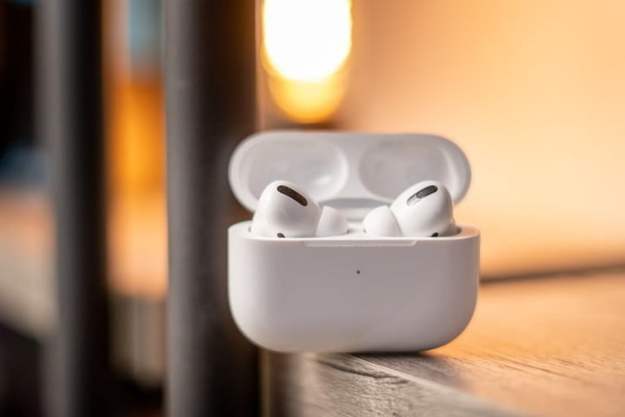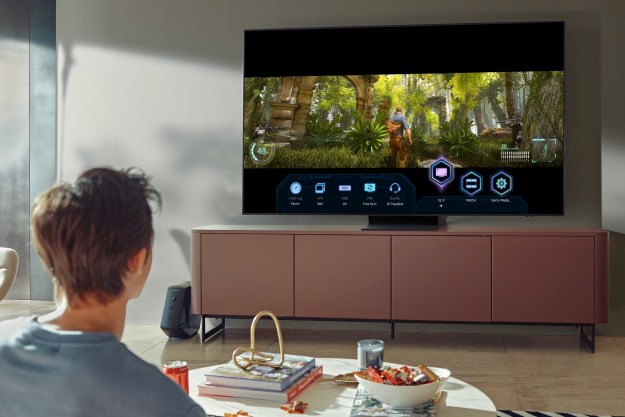If the idea of a neck-worn soundbar with enough bass to vibrate your collarbone sounds a little out there, that’s because it is. But LG’s Tone Surround, one of the newest additions to the Seoul, South Korea-based company’s lineup of portable audio products, pleasantly surprised us. Not only does it deliver on its promise of loud, punchy personal sound, but it’s ergonomic, comfortable, and far more compact than the promotional materials might lead you to believe.
The LG Tone Surround looks a little like a perforated, lopsided boomerang. It’s stretchy and bendable, which should make it easy to stuff hastily in a backpack or suitcase when need be. And it’s light enough that one Digital Trends staffer forgot he was wearing it.
The goods
It features four speakers in total, two on the top that handle high- and midrange frequencies and a pair of bottom-firing speakers that handle low tones. An integrated 32-bit, DTS-optimized audio DAC, meanwhile, upconverts audio to Hi-Fi quality. And a Bluetooth cable and 3.5mm cable provide the means to pair virtually any laptop, smartphone, or tablet out there. Once paired, plugged in, and ready, the Tone Studio acts just like any old wireless speaker — it’s plug and play.
One small caveat is that the Tone Studio isn’t compatible with antiquated TV sets — only the past two years’ worth of smart TVs from LG and Samsung. LG said it’s working on a dongle that’ll adapt it to work with other, older brands of TVs, as well as game consoles that don’t support Bluetooth.
The sound
We came around generally impressed by the Tone Studio’s sound. Several Digital Trends staffers noted the unique sensation generated by the down-firing speakers: While watching a particularly explosive scene in a trailer for Star Wars: The Force Awakens, the bass was palpable without drifting toward muddled territory. Higher frequencies were loud enough to hear comfortably at mid-volume. And though voices seemed a little muffled, they never came across as tinny or shrill — a frequent shortcoming of devices in the Tone Studio’s category.
Better yet, the Tone Studio generates what the company has coined a “sound field,” or something akin to an invisible, personal “sphere” of audio. It’s somewhat like a helmet: The Tone Studio’s ambient audio is much quieter to nearby folks.
The Tone Studio
The Tone Studio isn’t the only portable audio tech LG had on hand. The Tone Free, another new Tone series entry, was announced alongside the Studio. Like neck-worn Tone products before it, it features earbuds that pair to a smartphone or other portable device via Bluetooth. But unlike the previous generation of Tones, the earbuds in question pair independent of one another. They’re entirely wire-free — the neck-worn component serves as a charging dock.
The earbuds support voice commands and vibrate to indicate an incoming call, message, or other notification. And LG’s selling them alongside a new box-shaped accessory that provides a few additional hours of battery life.
LG hasn’t announced pricing or availability just yet, but a company spokesperson told Digital Trends the Tone Studio would retail for somewhere around $230, while the Tone Free would be “in line with LG’s previous Tone products” — around $100. Both are expected to launch later this year.
Conclusion
LG envisions the Tone Studio as an audio compliment to virtual reality headsets and home entertainment systems, and we generally agree. It produces a level of immersion that easily surpasses much of the competition. That’s not to say the Tone Studio will replace a surround sound system or soundbar anytime soon — it’s loudness doesn’t quit match that of a dedicated speaker’s. But the implications for personal audio are obvious — the Tone Studio is a solution for a crowded residence where loud, punchy audio is preferably kept to a minimum.
Highs
- Immersive sound
- Punchy bass
- Comfortable fit and form
Lows
- Muddled highs
Editors' Recommendations
- LG takes on the AirPods Pro with its Tone Free FN7 ANC
- LG’s Tone+ Free are true wireless earbuds for germaphobes





